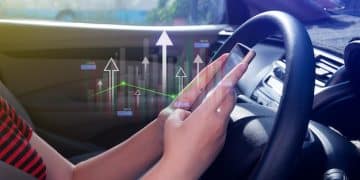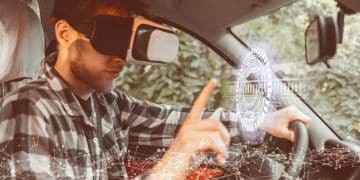Software-Defined Vehicles: Reshaping Car Ownership in the Next 5 Years

Software-defined vehicles (SDVs) represent a paradigm shift in the automotive industry, transitioning from hardware-centric to software-driven architectures, which will significantly impact car ownership by enabling personalized features, over-the-air updates, and new business models like subscription services within the next five years.
Get ready for a revolution on wheels! The automotive world is rapidly changing, and at the heart of this transformation lies the rise of software-defined vehicles: How Will It Change Car Ownership in the Next 5 Years? These aren’t your grandpa’s cars; they’re rolling computers!
The Dawn of the Software-Defined Vehicle Era
The automotive industry has long been dominated by mechanical engineering, but software is increasingly taking the lead. This shift has given rise to the software-defined vehicle (SDV), a car whose features and functionality are primarily controlled and updated through software, rather than hardware. Think of it as a smartphone on wheels, constantly evolving with new apps and capabilities.
But how did we get here? And, more importantly, what does the future hold for car ownership in a world increasingly dominated by SDVs?
The Evolution Towards Software-Defined Cars
The journey to SDVs has been gradual, marked by key milestones in automotive technology:
- Early Infotainment Systems: The introduction of basic navigation and entertainment systems laid the groundwork for integrating software into the driving experience.
- Advanced Driver-Assistance Systems (ADAS): Features like adaptive cruise control and lane-keeping assist demonstrated the power of software to enhance safety and convenience.
- Connectivity: The ability for cars to connect to the internet opened doors for over-the-air updates and remote diagnostics, paving the way for SDVs.
Today, SDVs are no longer a futuristic concept, but a tangible reality. Major automakers are investing heavily in software development and creating dedicated platforms for SDVs. This is not just about adding a few extra features; it’s a fundamental shift in how cars are designed, manufactured, and experienced.
In conclusion, the rise of SDVs signifies a revolutionary shift in the automotive industry, transitioning vehicles from hardware-centric to software-driven machines, promising continuous innovation and personalized experiences for drivers.
How SDVs Are Redefining Car Ownership
The software-defined nature of these vehicles is poised to change nearly every aspect of car ownership. From how you purchase a car to how you maintain and upgrade it, SDVs are ushering in a new chapter in automotive history. Let’s explore the most profound changes that are on the horizon.
One of the most significant changes is the potential for increased personalization and customization. Just as you customize your smartphone with apps and settings, SDVs will allow you to tailor your car to your specific needs and preferences.

Subscription Models and Feature-on-Demand
Imagine being able to subscribe to specific features for your car, such as advanced driver-assistance systems or premium entertainment packages. SDVs make this a reality.
- Flexible Feature Access: Pay only for the features you need, and upgrade or downgrade your subscription as your needs change.
- Continuous Improvement: Software updates can continuously improve the performance and functionality of your car, even years after purchase.
- New Revenue Streams for Automakers: Subscription models create new revenue streams for automakers, allowing them to offer more affordable upfront prices for vehicles.
The implications for car ownership are enormous. Instead of buying a fully loaded car with features you may never use, you can opt for a base model and add the features you want through a subscription. This could make car ownership more accessible and affordable for a wider range of people.
In short, SDVs are changing the game by introducing subscription models and feature-on-demand, offering personalized and flexible access to vehicle capabilities while opening new revenue streams for manufacturers.
The Impact on Car Maintenance and Upgrades
Traditional car maintenance has often been a dreaded experience for car owners. Frequent trips to the mechanic, unexpected repairs, and costly replacement parts are all part of the car ownership experience. SDVs, however, promise to change all of that.
With advanced sensors and connectivity, SDVs can continuously monitor their own health and performance. This data can be used to predict potential problems before they occur, allowing for proactive maintenance and repairs.
Over-the-Air Updates and Remote Diagnostics
One of the most significant benefits of SDVs is the ability to receive over-the-air (OTA) updates. These updates can fix bugs, improve performance, and even add new features to your car, all without having to visit a mechanic. Here’s how it works:
- Bug Fixes and Security Patches: OTA updates can quickly address any software glitches or security vulnerabilities that are discovered.
- Performance Improvements: Automakers can use OTA updates to improve the performance of your car, such as increasing fuel efficiency or improving handling.
- New Feature Additions: OTA updates can also add entirely new features to your car, such as new driver-assistance systems or infotainment apps.
Remote diagnostics further enhance maintenance by allowing mechanics to remotely diagnose and troubleshoot problems with your car. This can save you time and money by reducing the need for physical inspections.
As a result, SDVs are set to revolutionize car maintenance and upgrades, offering over-the-air updates and remote diagnostics for enhanced performance, timely repairs, and reduced downtime.
The Challenges and Opportunities for Automakers
The rise of SDVs presents both significant challenges and opportunities for automakers. To succeed in this new era, automakers must adapt their business models, invest in new technologies, and develop new partnerships.
One of the biggest challenges is the need to develop a strong software development capability. Automakers have traditionally been focused on mechanical engineering, but they must now become proficient in software development, cybersecurity, and data analytics.
Building a Software-First Culture
Transitioning to a software-first culture requires a fundamental shift in mindset and organizational structure.
- Attracting and Retaining Software Talent: Automakers must compete with tech companies for top software talent.
- Adopting Agile Development Methodologies: Agile development allows for faster iteration and more flexibility, which is essential in the fast-paced world of software.
- Fostering Collaboration Between Hardware and Software Teams: Effective communication and collaboration between hardware and software teams are essential for creating successful SDVs.

However, the benefits of transitioning to SDVs are numerous. SDVs offer automakers new revenue streams, increased customer loyalty, and the ability to differentiate themselves from competitors. By embracing software, automakers can create cars that are more personalized, more connected, and more intelligent than ever before.
Ultimately, SDVs present automakers with a dual challenge and opportunity: they must embrace software and adapt their business models to thrive in a new era of automotive technology.
Cybersecurity and Data Privacy Concerns
As cars become increasingly connected and software-defined, cybersecurity and data privacy become major concerns. SDVs collect vast amounts of data about drivers and their behavior, and this data could be vulnerable to hacking or misuse.
Automakers must take steps to protect the data collected by SDVs and ensure that drivers’ privacy is respected. This includes implementing robust security measures, encrypting sensitive data, and being transparent about how data is collected and used.
Securing the Software-Defined Vehicle
Here are some key areas to focus on to ensure SDVs are protected in the digital landscape:
- Robust Security Measures: Implementing firewalls, intrusion detection systems, and other security measures to protect against hacking attempts.
- Data Encryption: Encrypting sensitive data to prevent unauthorized access.
- Transparent Data Policies: Being transparent with drivers about how their data is collected and used, and giving them control over their data.
Cybersecurity is not just a technological challenge; it’s also an ethical one. Automakers must prioritize the privacy and security of their customers, even if it means sacrificing some potential revenue or convenience.
In essence, ensuring cybersecurity and data privacy in SDVs is crucial, requiring robust security measures and transparent data policies to protect drivers’ personal information.
The Future of Car Ownership: A Glimpse into 2030
Looking ahead to 2030, the landscape of car ownership will likely be vastly different than it is today.
SDVs will be commonplace, and cars will be more personalized, more connected, and more intelligent than ever before. Subscription models will be widely adopted, and car ownership will become more flexible and affordable.
The Car as a Service (CaaS) Model
One potential future scenario is the rise of the “car as a service” (CaaS) model. In this model, you don’t own a car outright; instead, you subscribe to a service that provides you with access to a fleet of SDVs. CaaS providers take care of all the maintenance, insurance, and other hassles of car ownership.
This means:
- Personalized Mobility: Get access to the right car for the right occasion, whether it’s a fuel-efficient sedan for commuting or a spacious SUV for a family vacation.
- Hassle-Free Car Ownership: No need to worry about maintenance, insurance, or depreciation.
- Access to the Latest Technology: CaaS providers will constantly update their fleets with the latest SDVs, so you’ll always have access to the most advanced technology.
The CaaS model could revolutionize car ownership by making it more affordable, more convenient, and more sustainable.
Therefore, the future of car ownership points towards a more flexible, personalized, and tech-driven environment characterized by the “car as a service” model.
| Key Feature | Brief Description |
|---|---|
| 🚗 Software Updates | Vehicles receive continuous improvements via over-the-air updates. |
| 🔧 Remote Diagnostics | Cars can be diagnosed remotely, reducing downtime and maintenance costs. |
| 🔒 Cybersecurity Measures | Enhanced security protocols protect against data breaches and cyberattacks. |
| 💰 Subscription Models | Pay-as-you-go access to specific features and functions alters ownership. |
FAQ Section
▼
Software-defined vehicles are cars where software plays a dominant role in controlling vehicle functions and enabling new features. They rely heavily on software for things like engine performance, safety features, and infotainment.
▼
Update frequency varies by manufacturer. Some SDVs may receive updates monthly, while others may be quarterly. Critical security patches could be deployed even faster. These updates improve performance and add new features.
▼
SDVs can be more vulnerable if security measures are not robust. Automakers must prioritize cybersecurity and implement strong security protocols to protect against potential attacks and data breaches.
▼
Subscription models for features and Car-as-a-Service (CaaS) may lower initial costs but could lead to ongoing expenses over time. The overall affordability depends on usage patterns and subscription choices.
▼
SDVs can simplify maintenance by predicting issues with advanced sensors. Remote diagnostics reduce visits to repair shops, and over-the-air updates address many software-related issues without needing physical servicing.
Conclusion
The rise of software-defined vehicles: How Will It Change Car Ownership in the Next 5 Years? signals a transformative shift in the automotive industry, promising personalized, connected, and intelligent driving experiences. While challenges remain around cybersecurity and data privacy, the opportunities for automakers and consumers alike are immense, potentially reshaping the very notion of car ownership in the years to come.





